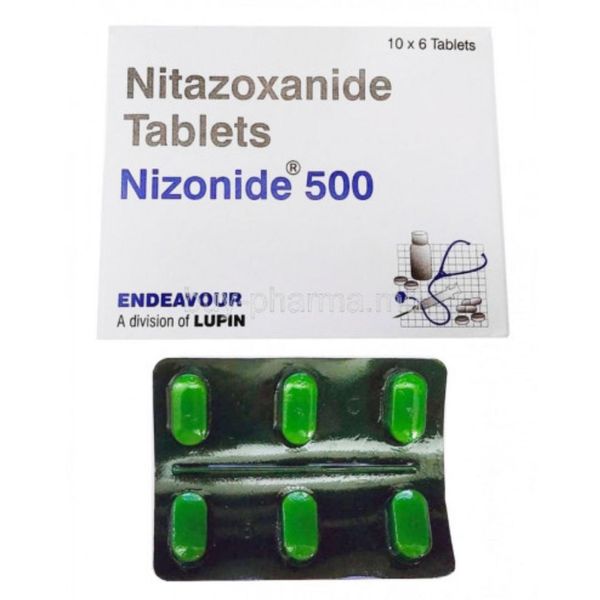|
Quantity
|
Out of stock
|
||
|
|
|||
Nitazoxanide
Analogues (generics, synonyms)
Nizonide, Nitazod
Active substance
Nitazoxanide (Nitazoksanidum)
Pharmacological group
Anthelmintics
From the same pharmacological group
Albela, Vermox, Azinox, Levamisole, Pyrvinium, Praziquantel
Prescription
international:
Rp.: Nitazoksanidi 0.5
D.t.d. No. 18 in tab.
S.: Orally, 1 tablet twice a day, strictly with a 12-hour interval between doses, during meals
Rp.: "Nitazoksanid" 100 mg/5 ml
D.S.: Orally, 10 ml 2 times a day, during meals
Russia:
The drug is not registered in Russia
Pharmacological action
Anthelmintic
Pharmacodynamics
Nitazoxanide is a broad-spectrum antiparasitic and antiviral drug used to treat various helminthic, protozoal and viral infections. It is indicated for the treatment of Cryptosporidium parvum and Giardia lamblia infections in immunocompetent patients, and for the treatment of influenza. Nitazoxanide has in vitro antiparasitic activity and clinical efficacy against other protozoan and helminth infections (e.g., Entamoeba histolytica, Hymenolepis nana, Ascaris lumbricoides, Cyclospora cayetanensis). Nitazoxanide has been reported to be effective against a number of viral infections.
Pharmacokinetics
Nitazoxanide is rapidly metabolized to the active metabolite tizoxanide. The initial reaction in the metabolic pathway of nitazoxanide is hydrolysis to tizoxanide followed by conjugation, primarily glucuronidation to tizoxanide glucuronide. In vitro, nitazoxanide and tizoxanide inhibit the growth of Cryptosporidium parvum sporozoites and oocysts and Giardia lamblia trophozoites.
Tizoxanide plasma protein binding is over 99%. The half-life of tizoxanide (T½) is 1–1.6 hours. Elimination with urine is ~33%, with feces – ~67%.
Method of administration
for adults:
Orally (inside), during meals
Adults and children over 12 years old
Tablets 500 mg every 12 hours × 3 days.
for children:
Suspension:
1–3 years: 5 ml (100 mg) every 12 hours × 3 days, during meals
4–11 years: 10 ml (200 mg) every 12 hours × 3 days, during meals
Indications
Treatment of diarrhea in adults and children caused by the protozoa Giardia lamblia, Cryptosporidium parvum.
Contraindications
- Hypersensitivity to nitazoxanide.
- children under 1 year of age (for suspension)
children under 12 years of age (for tablets)
With caution
Hepatic/renal insufficiency.
Special instructions
The pharmacokinetics of nitazoxanide in patients with renal insufficiency or hepatic dysfunction has not been studied. Therefore, nitazoxanide should be administered with caution to patients with hepatic and biliary disease, patients with renal insufficiency and patients with combined renal and hepatic disease.
Side effects
The most common side effects, regardless of the assessment of causal relationships, were: abdominal pain (7.8%), diarrhea (2.1%), vomiting
(1.1%) and headache (1.1%). They were usually mild and transient in nature.
The following adverse reactions occur in less than 1% of pediatric patients:
Gastrointestinal: nausea, anorexia, flatulence, increased appetite, increased salivation.
General disorders: fever, infection, malaise.
Laboratory tests: increased creatinine, increased SGPT. Skin: pruritus, sweating.
Special sensations: discoloration of the eyes (pale yellow).
Respiratory system: rhinitis.
Nervous system: dizziness. Urogenital system: discolored urine.
In adult patients receiving nitazoxanide oral suspension, the reactions were similar to those observed in adult patients receiving nitazoxanide tablets.
Overdose
No data
Drug interactions
Caution should be exercised when using nitazoxanide simultaneously with other drugs that are highly bound to plasma proteins and have narrow therapeutic indices, as competition for binding may occur (eg, warfarin).
Dosage form
Tablets of 500 mg, 200 mg and suspensions (100 mg per 5 ml)
































